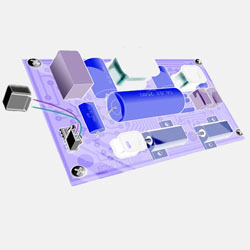Three octaves or 3.2 octaves (1 decade) is the optimum bandwidth for a loudspeaker (a topic which we’ll touch on later). The crossovers function is to decrease power at a given rate from either or both sides of a given bandwidth.
The slopes rotate phase in opposite directions. In some passive crossovers this is adjusted for by reversing the polarity of adjacent loudspeakers. Electronic active crossovers can have extra compensating circuitry.
Crossover Points & Order
At the crossover point, power to each loudspeaker is reduced -3 dB (1/2) so total sound energy is 1. At the crossover point sound comes from two sources and on-axis directivity is increased. More recent design trends are for power to be decreased to -6 dB (1/4) to each loudspeaker at the crossover point, and the slope rate can be selected.
1. First order (-6 dB /octave) reduces power to 1/4 per octave, adequate for lower cost, low-power systems.
2. Second order (-12 dB /octave) reduces power to 1/16 per octave, which provides the best technical accuracy with the least complications and harmonic distortion. For mid and high loudspeakers, the cone or driver diaphragm movement is kept constant as the frequency decreases (constant excursion).
3. Third order (-18 dB /octave) reduces power to 1/64 per octave, good for protecting loudspeakers at higher power. Also helps reducing bass energy from harming compression drivers with truncated horns.
4. Fourth order (-24 dB / octave) reduces power to 1/256 per octave, best for maximum control of loudspeakers, but requires critical alignment which is rarely achieved.
Fourth order has become the standard crossover for professional systems.
3 Laws of Crossovers
1. It’s not possible to stitch two different loudspeakers together, perfectly.
2. A crossover should have the minimalist complexity to achieve the desired outcome.
3. The more complex a crossover, the more difficult the system is to control.
Selecting Crossover Points
Our ears are most sensitive to detail between 300 Hz to 3 kHz. As a reference, the telephone system operates between these two points. Sound system distortion between these points can easily be heard and therefore the worst position to cross speakers over, but we have no choice. The best crossover points for our ears do not line up with the physics of loudspeakers.
For domestic use at low power, crossing tweeters over between 2 kHz—3 kHz is often done in 2-way systems. However, the tweeter is easily destroyed at higher power (particularly when having parties). There has been many attempts to force loudspeakers to be crossed over at 300 Hz and 3 kHz at higher power, but with limited success.
The sound spectrum is large 20 Hz to 20 kHz (three decades or nine octaves). For “consumer” loudspeaker systems, a passive full-range 3-way speaker system is cost effective and adequate for most people. The best way to understand a 4-way loudspeaker system is to approach it a 3-way, with an added active bass (sub-bass). Hopefully the explanations below will make this understandable.


















